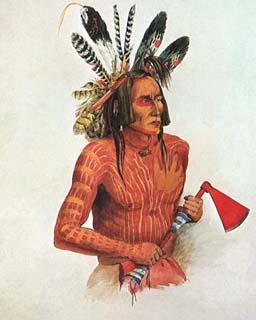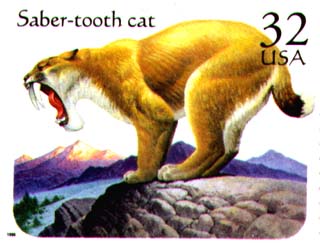Anth 3511 Professor Gibbon
Hunter-Gatherers and the Holocene
1. Introduction. This classroom period reviews the Clovis culture, radiocarbon dating, hunter-gatherer theories, and environmental periods in North America during the Holocene (i.e., the post-Ice Age period).
2. Clovis culture (11,200-10,900 years ago).
A. Small family groups of hunter-gatherers using the Clovis fluted projectile point rapidly spread throughout North America at the end of the Wisconsin glacial period. They are an Early Paleoindian culture.
Ice Age Maps of North America
B. They probably had a focus on larger game animals, where possible, but were opportunistic hunter-gatherers who captured smaller mammals and fish, and collected wild plant foods, when necessary.
C. The Clovis toolkit included stone projectile points/knives, scrapers, and butchering tools, and some bone tools. Stone for points was of a high quality and often obtained from distant areas. This is the tool kit of a hunter.
D. Clovis is best known from mammoth and now extinct bison kill sites (e.g., Lehner and Murray Springs in Arizona) in the plains and Southwest, but thousands of isolated points are scattered across the continent.
E. Clovis origins are unclear, but they are thought (at least by Fagan) to have originated in Alaska as an extension of a bifacial point-making Eurasian big game hunting tradition. Possible early sites in Alaska include Mesa and Dry Creek, although these are not Clovis. Clovis then spread rapidly southward.
F. Clovis hunters may have been involved in the extinction of Ice Age megafauna, but it remains an undemonstrated hypothesis. However, a rapid diversification of Paleoindian cultures took place after about 10,900 years ago.
2. Dating conventions. Archaeologists employ a bewildering array of conventions in dating periods and events in prehistoric North America. Beware!
A. BP. (before present) means before AD. 1950, otherwise an event that occurred 500 years ago for an archaeologist writing in AD 1900 will have happened 600 years ago for his great granddaughter writing in AD 2000.
B. North American archaeologists are increasingly using radiocarbon BP dates because some peoples object to the use of the Julian calendar' s BC (before Christ) and AD (anno Domini, since the beginning of the Christian era).
C. Other advantages of using radiocarbon dates are that (1) they are neutral (e.g., independent of archaeologists' ideas about the age of a site), (2) an absolute (rather than relative) age determination, and (3) their most effective range is 50,000-500 years ago, which easily spans the bounds of the prehistoric record on this continent.
D. We must be aware of two sources of confusion in using radiocarbon dates:
(1) because of variable rates of decay of C-14, radiocarbon dates have a statistical error range that can span hundreds of years. Furthermore, there are only 2 out of 3 chances that the correct age is within the span. Accelerator mass spectrometry (AMS) dating, which counts numbers of atoms, has a much shorter error range (20-30 years).
Uneven production rates of C14 in the atmosphere means that there is a discrepancy between C14 and calendar dates. Radiocarbon dates have to be calibrated (see the handout and Fagan p. 12).
3. Hunter-Gatherer theory. Since most prehistoric North Americans were hunter-gatherers, North American archaeologists have a special interest in hunter-gatherer theories. Among these theories are:
A. Evolutionary theories. Hunter-gatherers are "primitive," representing a stage before the development of more complex life ways.
B. The Forager-Collector model. Lewis Binford's forager and collector ideal type systems. Most hunter-gatherers were somewhere in between.
C. Optimal Foraging theory. Assumes human decision are made to maximize the net rate of energy gain (so capture one bison rather than 10,000 mice).
D. Mini-Max theories. Assumes that people try to get the maximum return for the least effort (Let's go out for two hours and see what we can find.)
E. Climatic change theories. Changes in hunter-gatherer life ways were primarily triggered by changes in the natural environment.
F. Population growth theories. The gradual growth in the overall population forced adjustments in subsistence-settlement systems.
G. Resource Stress and Hunter-Gatherer diversity. Assumes people will adopt subsistence-settlement strategies that help them minimize periods of resource stress.
4. Holocene climatic change in North America
A. Three major climatic periods are recognized for the post-Ice Age period: the Early (ca. 10,500-6500 BC), Middle (6500-2000 BC), and Late (ca.2000 BC to present) Holocene.
B. Basically, the Early Holocene was a rapid adjustment to warmer conditions, the Middle Holocene a very warm and probably dry period, and the Late Holocene a period of essentially modern conditions. C. Since climate influences plant and animal communities, hunter-gatherers during the Early and Middle Holocene were continually adjusting to changing environments.
D. Holocene climatic changes can be traced in many ways, including pollen diagrams, deep-sea cores, tree-ring fluctuations, pack-at middens, and rate ofsedimentation.
E. It is essential, then, for a processual archaeologist to know what the environment was like at any one time in the Holocene.
Go To The Index Page



